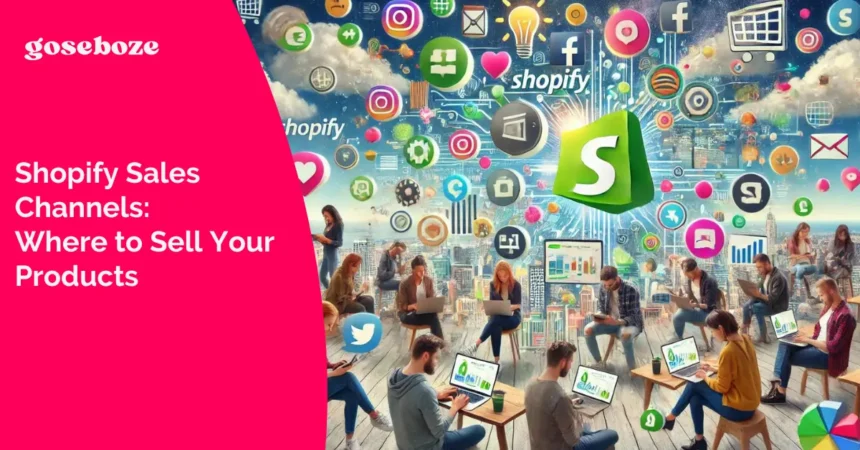Shopify has become a powerful tool for businesses looking to sell products online, offering flexibility and ease of use. One of its most beneficial features is its Sales Channels, which allow sellers to distribute products across multiple platforms, increasing visibility and sales. Understanding where to sell your products is key to maximizing your business’s reach and ensuring sustained growth. In this article, we’ll explore the different Shopify sales channels available and how they can benefit your business.
Why Shopify Sales Channels Matter
Expanding your sales beyond your Shopify store gives you the ability to tap into various consumer bases. Each platform, whether it’s social media, marketplaces, or even connected TV advertising, attracts different customer demographics. By utilizing multiple sales channels, you increase brand exposure, drive demand generation, and allow for more precise targeting of your audience.
Key Benefits of Using Multiple Shopify Sales Channels:
- Increased visibility: More platforms mean more exposure.
- Diversified revenue streams: Sales don’t rely on one channel.
- Customer convenience: Sell where your audience already spends time.
- Enhanced performance marketing: Track customer behavior across different platforms.
Now, let’s dive into the most effective Shopify sales channels to consider for your business.
1. Shopify Online Store
Your Shopify online store is the foundation of your sales efforts. It provides you with full control over branding, user experience, and product presentation. As this is your primary storefront, everything you do should ultimately drive traffic back here. Use it as the central hub for all other Shopify sales channels.
Key Features:
- Full customization of the online store.
- Integrated performance marketing tools.
- Ability to run special promotions and campaigns.
Leverage your Shopify store for personalized marketing strategies and offer exclusive products to drive higher engagement.
Read Also: Perfect Brunch Dresses Paired with Custom Headpieces: Shop Millinery Supplies Online
2. Social Media Sales Channels
Social media platforms have become vital sales drivers for businesses. Shopify integrates with several key social platforms, allowing you to sell directly from your business accounts.
a) Facebook Shop
Facebook Shop allows you to create an online store within Facebook, seamlessly syncing with your Shopify inventory. With over 2.8 billion monthly active users, Facebook gives you access to a massive customer base.
- Shoppable posts: Make your Facebook posts interactive by tagging products.
- Enhanced customer engagement: Reach users through targeted ads and content.
- Messenger integration: Customers can communicate with you directly.
b) Instagram Shopping
Instagram Shopping connects your Shopify store to Instagram, where users can shop directly from your posts and stories. This is a powerful platform, especially for businesses that rely on visually-driven marketing.
- Shoppable stories and posts: Tag your products in both static posts and stories.
- Targeted advertising: Use performance marketing to retarget customers based on their interactions with your content.
Both Facebook and Instagram can significantly increase demand generation through a combination of organic reach and paid advertising campaigns.
3. Marketplaces
Online marketplaces are another lucrative Shopify sales channel. They offer instant access to millions of potential customers who are actively searching for products.
a) Amazon
Amazon is one of the world’s largest online marketplaces, and Shopify’s Amazon integration allows you to sell seamlessly on this platform. This integration is ideal for businesses looking to scale quickly, as Amazon’s sheer size offers high visibility.
- Instant credibility: Consumers trust Amazon for its reliable delivery and service.
- Fulfillment options: Utilize Fulfillment by Amazon (FBA) for logistics management.
b) eBay
eBay remains a go-to platform for both new and used goods. Shopify allows for easy integration with eBay, so you can manage listings, orders, and inventory all from your Shopify dashboard.
- Diverse customer base: Tap into eBay’s wide audience, including those searching for niche products.
- International reach: Sell to customers in various countries where eBay has a strong presence.
4. Google Shopping
Google Shopping is a powerful way to get your products in front of customers who are actively searching for what you sell. With Shopify’s Google channel, you can sync your inventory and create ads that appear in Google search results and the Shopping tab.
Benefits of Google Shopping:
- High-intent traffic: Reach users who are actively searching for specific products.
- Product listings with images and prices: Increase the likelihood of clicks and conversions.
- Integration with Google Ads: Combine Google Shopping with broader programmatic advertising campaigns.
Google Shopping is particularly effective for businesses focused on performance marketing, as it allows you to target users with high purchase intent.
5. Pinterest
Pinterest is another visually-driven platform that works well for certain niches, especially lifestyle products, home decor, and fashion. With Pinterest Shopping, you can upload your Shopify inventory and make your products discoverable on the platform.
Key Features:
- Pins linked to product pages: Let users click through from Pinterest directly to your Shopify store.
- Visual search: Users can find products that resemble pins they’ve saved or liked.
Using Pinterest for demand generation works especially well if your products are visually appealing and can capture attention quickly.
6. Connected TV Advertising
As OTT (over-the-top) platforms grow, connected TV advertising is becoming a vital channel for eCommerce businesses to explore. While Shopify doesn’t directly integrate with CTV platforms, running ads that promote your Shopify products on CTV can be a game-changer.
Benefits of CTV Advertising for Shopify Sellers:
- Targeted marketing: Reach specific audience segments through programmatic advertising.
- Cross-device tracking: Monitor how customers engage with your ads across multiple screens, leading to better performance marketing.
- Enhanced brand visibility: The big-screen experience increases the likelihood of engagement.
For businesses already running ads on Shopify’s sales channels, CTV advertising can act as a supplementary method of building brand awareness and driving traffic to your store.
7. Buy Button
The Buy Button is a unique Shopify sales channel that allows you to sell your products on any external site or blog. This is a great option for businesses that already have established websites but want to offer products through Shopify’s streamlined checkout process.
Benefits:
- Customizable appearance: Match the button to your website’s design.
- Increased flexibility: Place your products on different websites without opening a full Shopify store.
- Integrated inventory management: All sales go through your Shopify dashboard, making inventory and order tracking easier.
8. Shopify POS (Point of Sale)
For businesses that sell both online and in physical locations, Shopify’s Point of Sale (POS) system allows for seamless integration between brick-and-mortar and online operations. Shopify POS connects with your Shopify store inventory, making it easy to manage both online and offline sales in one place.
Key Benefits:
- Unified inventory: Track stock levels across both online and physical stores.
- Omnichannel experience: Offer customers the ability to buy online and pick up in-store.
- In-store promotions: Run in-person events and promotions that link directly to your Shopify account.
9. Mobile Apps
Shopify also allows integration with mobile apps for businesses looking to create a mobile-first shopping experience. Having a dedicated mobile app gives you direct access to your customers, with push notifications, exclusive promotions, and a user-friendly shopping experience.
Benefits:
- Improved customer retention: Engage users with notifications about new products and deals.
- Personalized shopping: Offer tailored experiences based on user behavior.
- Loyalty programs: Incorporate loyalty programs that reward repeat purchases.
Mobile apps can work in conjunction with other channels like connected TV advertising, as ads on CTV can prompt app downloads, leading to further engagement with your brand.
One often underutilized tool for enhancing sales channels is QR codes. They provide a seamless way to connect offline marketing materials, such as brochures and posters, to online content. By implementing QR codes in your strategy, you allow customers quick access to your Shopify store from any print material. You can easily create QR codes with Bitly, which offers robust tracking features to monitor engagement and gather insights.
Conclusion
Choosing the right Shopify sales channels can significantly boost your business’s reach and sales. Whether you’re focusing on social media, marketplaces, or even newer technologies like connected TV advertising, integrating multiple channels into your Shopify store can diversify your revenue streams and improve overall performance. Each channel offers unique benefits, so it’s essential to pick those that align with your target audience and business goals.








